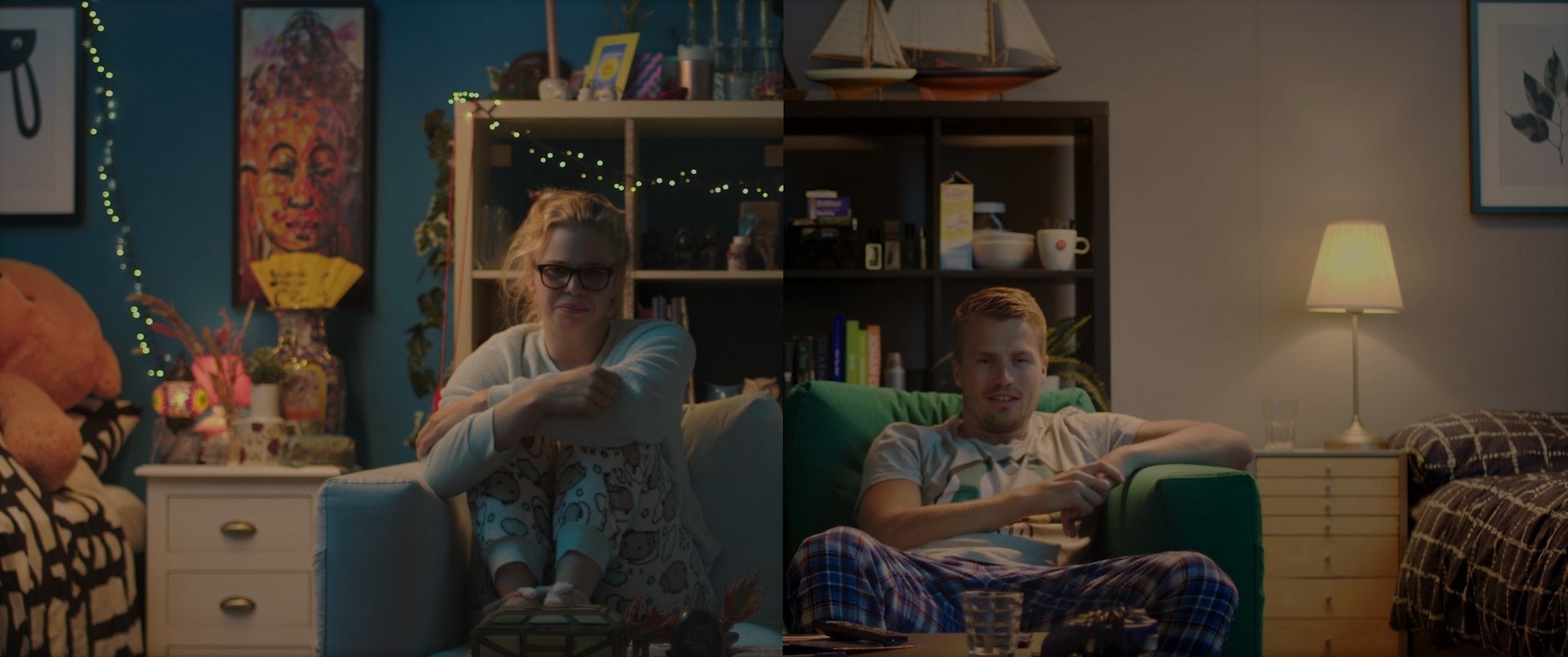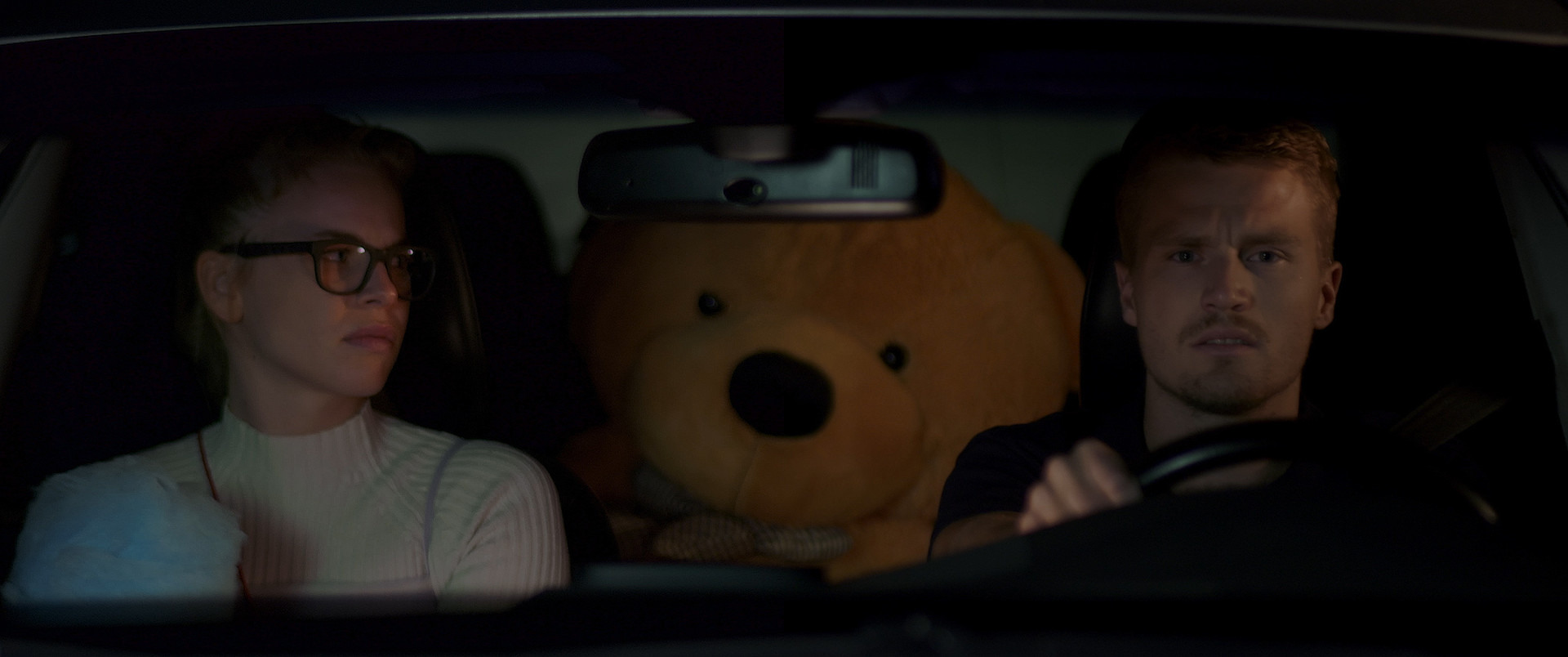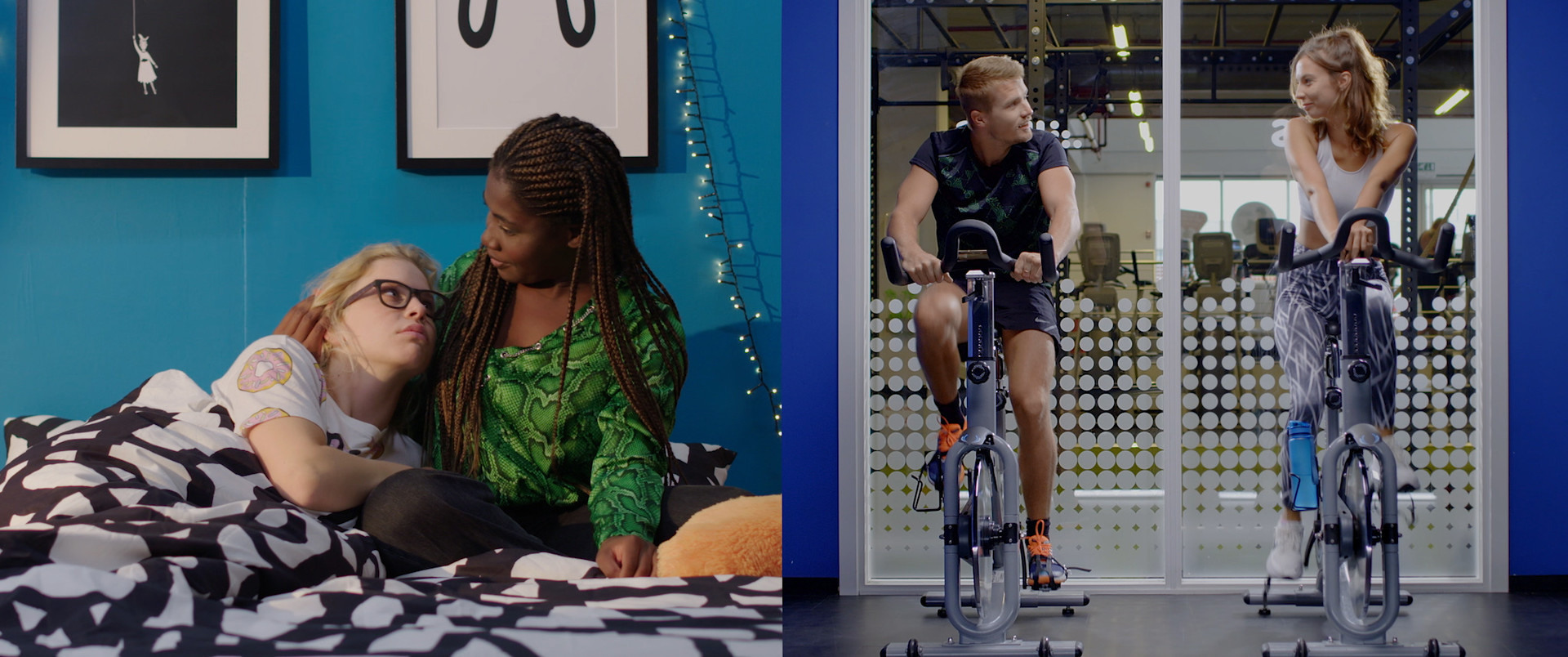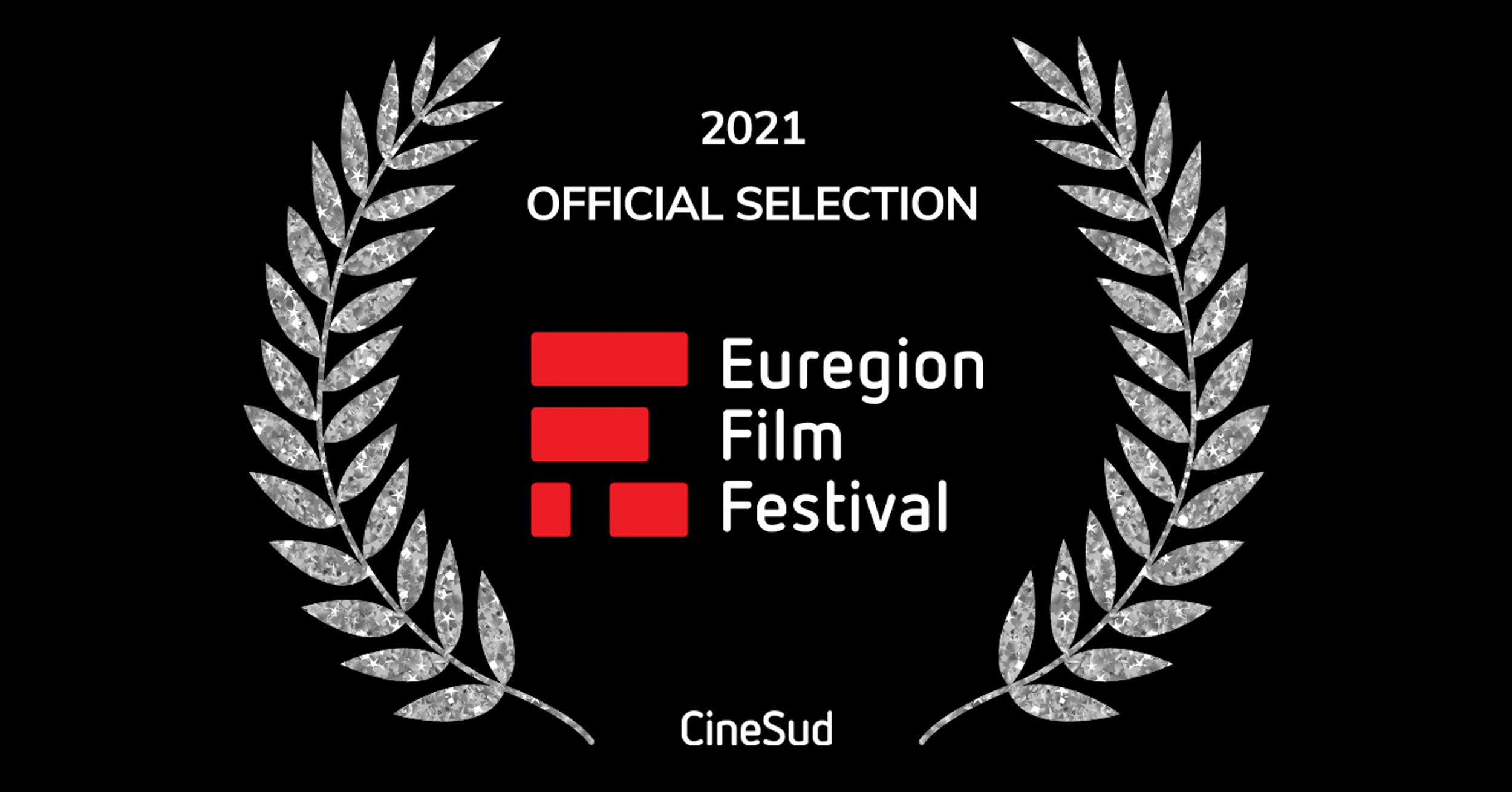
Case Study: Split-Up
Katja Jansen made a technically very challenging film.
Geplaatst op 13 februari 2021Her film had to stand out between all the other graduates, so Katja Jansen challenged herself in a big way. Using split-screen for her tragicomedy Split-Up, the ambitious filmmaker needed to explore every new possibility and limitation. In anticipation of the Euregion Film Festival, Jansen looks back at the process of making her short movie.
"I think the really scary thing about directing a split-screen movie is not knowing how everything will look together."
Making a split-screen film
"I thought of the idea for my short film during my third year of film school. We had to make a short film with the whole class and I pitched the idea of a split-screen film about a break-up to my classmates, but the idea was not chosen. In my final year of film school, my fourth year, I had to make a short film to graduate. I wanted to make something special, not just a regular short movie. I wanted my short to stand out amongst the others and wanted to use the 'safety' of my school to experiment with film. I had many other ideas for shorts, but chose to make a split-screen movie."
"The idea of making a split-screen film about a break-up, was very clear. I would have two characters, both enclosed in their split-screens, and we would follow them after the break-up. Who the characters would be and what they would do, was not very clear. I had some ideas for funny scenes and I really wanted to use the split-screen as best as possible. Not only to show contrasts and similarities and hopefully generate humour that way, but also to evoke the feeling of sympathy for the characters.""I just started writing a lot of treatments under the supervision of my teacher who specializes in fiction and directing. While writing the treatments I got a sense of the possibilities of the film and I explored them all. At one moment the film would take place over several days, and at other times it would take just one day. At the end I think I made the most compact and 'clean' version the film could be. No unnecessary scenes, characters or film locations. Everything was intentional."
Learning from experiments
"During the writing process, I experimented a lot with split-screen with my DOP. The plan was to have some shots that would go from a normal shot to a split-screen shot. We started experimenting with two of the same cameras and trying to make one whole shot with the two pictures. Fortunately this worked! We then began testing with having the camera's on dollies and going from one shot to two, and from two to one. This also worked! Besides the technical tests I also did a more substantive test. Together with my brother we filmed the couch scene at home so I could see how it all would work out in the edit."
"I really learned a lot from this. I now know about the importance of continuity (when you are constantly seeing two characters at the same time and you don't have cut-aways), the impact of cuts on the viewer (people are attracted to the image with most change, so they will be drawn to the split-screen where a cut takes place), cuts in general (do you have to cut at the same time, or can you alternate?), and the importance of visually matching the furniture. And a lot more."
"I did not only write and direct this movie, but I also produced (and edited) it.So I arranged everything for the shoot myself. Location scouting really helped me during the writing process, because it made everything tangible. It helped me visualize everything together with my DOP. This is also why we waited a really long time to actually write down the shotlist, because we both had the same shots in our heads. So writing the shotlist down was very easy."

Building two sets from scratch
"I wanted to make the two student rooms of the film visually the same, to get striking similarities. That way it would look like the characters are sleeping in the same bed or sitting on the same couch. For this reason I decided to build two sets for the student rooms. Luckily my school has two studios where we could build the sets. It was a real hassle to get all the furniture to the studios. Fortunately my brother had a lot of his student room furniture at home, so I could borrow that. I also used a lot of my own furniture, which was nearby."
"I think building the sets from scratch was a very good choice in the end, because it was quite easy for us to get precisely matching shots, because the rooms were mirrored. Finding matching furniture was really hard. I measured a lot of furniture we had a home, but nothing really matched. For this reason I just decided to use the same furniture, but disguise that it is actually the same, by using different bedding, a different cover for the couch or paste some paper on the coffee table. In this way the key furniture was the same and I could decorate the rooms with little accents to make them different."
Financing the film
"I had to finance my film on my own. But I could use the studios and filming equipment from my school, which greatly reduced the cost. Furthermore, my crew consisted of a lot of younger students whom I didn't have to pay. I only hired a professional sound recordist, gaffer and make-up artist. The only mistake I made was sometimes trusting people a bit too much about their technical skills. For example, my 1AC, the person who has to keep the shot in focus, really didn't do a good job."
"So I got a lot of things for free to make my movie. But I still needed money for additional equipment, food for the crew, paying the actors and special crew, and other things. I collected the money I needed for this by winning a pitching competition (€1000) , getting some funding from my mom (€500), filming an interview for my uncle (€500), working at my school (€660), crowdfunding (€440), getting food from a local grocery store (€50) and rent saving (€1080). I cancelled my rent three months earlier than planned, because I could live at home and do most of the post production from there.

Technical challenges
"Not everything went as planned during production. I initially had to cancel the shooting days. The pandemic was just beginning and I was finalizing my sets on Friday, while the shoot would begin on Monday. That day I heard that the school would be closed. Since my sets were built in the school, I couldn't possibly shoot the film. After a lot of debating I decided to start pre production again, to shoot in the beginning of September. I had to find my actors and crew all over again, but fortunately a lot of them were still able to help me out.
"When we finally were able to shoot in September everything went quite well. I actually removed one scene from the script during preparations and I think that made us overall more prepared for the shoot. Directing this film during the shooting days was quite hard. I have never directed a short movie before, so to direct a split-screen film as your first big project is not very smart maybe, haha. It is actually really hard to direct a split-screen film, because you are constantly thinking about two scenes at the same time."
"I prepared the shoot really well with my script supervisor and thought a lot about how to get the timing right. During rehearsals at the day of the shoot, I discussed with my actors which cues they wanted and how they wanted them. That way they would be able to act their own scenes without focussing to much on the other. This worked quite well. I think the really scary thing about directing a split-screen movie is not knowing how everything will look together. For 'normal' split-screen scenes, I always had the fear that the timing of the scenes together would be off and for the technically hard scenes I was afraid the two shots we filmed separately at the same time would not become one whole image. Actually nothing was perfect in the edit, but because I shot 4K and would render my project to be 2K, I had a lot of wiggle room to match shots 'perfectly'."
"Editing a split-screen movie is sometimes really exciting and sometimes really hard. I wrote my script in two columns so that I would know what would happen at the same time and what would not, but in the edit I really tried working with the material and not forcing my initial vision of the film. I would try out a lot of different takes to just see how it would alter the pacing of the scene."
"In one scene the pacing of dialogue changed because of this and I think the end results works better than what I had planned in the script. I think I finished the rough cut in a couple of days. I worked really fast because the deadline for school was quite strict, so I didn't really have a lot of time for re-edits. The rough cut actually looks a lot like the final cut. Only small changes were made and I completely re-edited one scene. I did this because I thought the scene would be better when I started from scratch. Just trying different takes together and seeing how they worked, helped making the overall scene a bit shorter and better."

Music, grading, premiere
"During the edit I added music to my film. I already chose a lot of the music or some options for particular moments before the shoot, so it was easy to put the music under the edit. This also really helped getting the right feeling of the film, even though you were seeing a rough cut. A fellow classmate did audiopost for me. I thought it was really fun to see how the film came together in audiopost, because it was essential that the sound of the film was mostly split, and I didn't touch the audio in the edit."
"Colour grading was quite a hard process for some scenes which were overexposed, but for other scenes it was fun. Here is a fun story: the colour grader and I were looking at a shot and I was noticing a weird blue stripe in the middle of the frame. He could not erase this and than he temporarily removed the other split-screen frame to look at the problem better and the stripe disappeared. It was so weird, because the stripe is not actually there. Only when the two shots are together, your eye gets tricked and sees a stripe."
"Overall I am quite happy with my movie. I think I really used the split-screen technique in a clever way to elevate my story. My short has already been shown at Leuven Short Film Festival and people really liked it that my film is a comedy. I also really noticed this while watching other films that screened at the festival. My film was quite light and fun, while the other films dealt with really heavy subjects or were really slow paced. I'm not saying those films are not good, not at all, but I think it is refreshing to have a more fun and fast paced film once in a while."
"My film didn't win any prices or special recognition. I actually received a zero star review from a critic. I think that my film may be a bit too commercial for some people, because of the simple storyline and fast pace. But a lot of people actually enjoyed my film. I was glad I could make something that could be enjoyed."
(c) All visual material is used with the filmmaker's permission.
